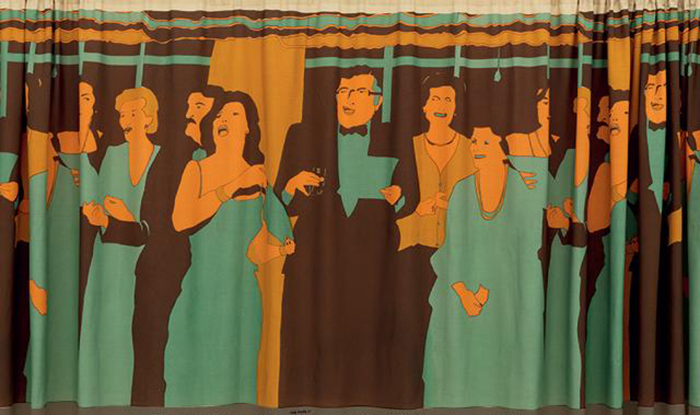
Artists who transformed Contemporary Art in Latin America 2
Artists who transformed Contemporary Art in Latin America 2
Feliza Bursztyn
Colombia (1933-1982)

Feliza Bursztyn challenged traditional methods of teaching sculpture in Colombia, re-signifying unconventional, discarded materials and granting them unprecedented value: scrap metal, car remains, and industrial waste materials were animated with movement, sound, and interaction. After studying in the United States at the Arts Students League, she moved to Paris to study with master sculptors and she returned due to a family calamity to Colombia to experiment and live in her home-workshop. She won the first prize for sculpture at the XVII National Salon in 1965. Her series Chatarras, Histéricas and her public sculptures showed an artist with a powerful conceptual and material vision, a woman who lived outside social conventions, an artist who had She became an expert in casting and handling ruined industrial material and thought about sculpture in relation to space. In 1974, in her exhibition Las Camas de ella, Bursztyn staged machines made with motors covered in colored fabrics. The vibrating and sound sculptures looked like intertwined couples and alluded to the sexual, the forbidden. A great scandal at the time. In 1980, under the application of the Security Statute, Feliza was accused and persecuted by the army in the most infamous way, forcing her into exile in Mexico and Paris until her death.
Teresa Burga
Peru (1935-2021)

Teresa Burga is a Peruvian artist who put the female body at the center of her practice. Her paintings and sculptures question feminine stereotypes and patriarchal hierarchies. She was one of the founding members of the Grupo Arte Nuevo, a Peruvian pop-conceptual avant-garde movement between 1966 and 1968, a time in which the colorful figurative paintings that functioned as parodies of the patriarchal representation of women were important. After a period in Chicago where she completed a master's degree in arts, she returned to Lima to do her more experimental work through installations, performances and drawings on newspapers where she documented the lives of Peruvian women, analyzing the stereotypes that were imposed on them and reflecting about the imaginary from which they operated.
Beatriz Gonzalez
Colombia (1938)

“I wonder why the hell the photo of the suicides in the newspaper caught my attention. Was it the grayness of the face, or was it the popular thing about two people entering into a suicide pact and joining hands for a photo they send to their families? The Sisga Suicides is one of the emblematic works of Beatriz González, for whom press photographs and media information served as raw material to define with solid chromatic blocks a body of work made of paintings, serigraphs and painting-objects. In her early work, reflection on the way in which art history reaches South American countries through low-cost reproductions was very present, reproductions that after appropriation became icons. Then came the works with scathing and direct criticism of the heroes of Colombian history, the allusion to the portraits of respectable families in the social section, the images of the red chronicles, popular prints and popular furniture. González explores people's tastes and ironically exposes their reality.






- April 17, 2025
The Global Art Market Faces a Recession Amid Global Crises



- April 17, 2025
Gallery Of Humor Drawing By Swaha - France

- April 17, 2025
12 Houses with Art Studios in Latin Ame…

- April 16, 2025
Famous 20th-Century Painters and Their …

- April 14, 2025
Analysis of Artistic Works Created with…

- April 13, 2025
From Digital Art to Contemporary Art

- April 13, 2025
The Expansion of Photography

- April 12, 2025
When is photography considered art?

- April 10, 2025
Impact of AI on the Diversity of Artist…

- April 10, 2025
How can AI enhance artistic creativity?

- April 09, 2025
The Impact of Artificial Intelligence o…

- April 08, 2025
Latin American art, a goldmine of oppor…

- April 07, 2025
Contemporary Art in Brazil: Between the…

- April 07, 2025
Mexican Muralism: Art for the People

- April 06, 2025
History of graphic art in Brazil

- April 05, 2025
Modern Art: A Renaissance in Art History

- April 02, 2025
Aldo Estrada (Ilustronauta): From Peruv…

- March 31, 2025
How ChatGPT is Turning Photos into Japa…

- March 30, 2025
Arístides Hernández (ARES): A Sharp Min…

- March 30, 2025
The Masters of Cuban Caricature: Celebr…

- March 29, 2025
Where Will Artificial Intelligence Take…

- March 27, 2025
A Few Fascinating Features of Latin Ame…

- August 29, 2023
The history of Bolivian art

- February 19, 2024
Analysis and meaning of Van Gogh's Star…

- January 28, 2024
Culture and Art in Argentina

- September 25, 2023
What is the importance of art in human …

- September 23, 2023
What is paint?

- August 10, 2023
14 questions and answers about the art …

- August 30, 2023
First artistic manifestations

- August 23, 2023
The 11 types of art and their meanings

- August 16, 2023
The 15 greatest painters in art history

- March 26, 2024
The importance of technology in art1

- September 23, 2023
History of painting

- April 06, 2024
History of visual arts in Ecuador

- January 31, 2024
Examples of Street Art – Urban Art

- March 26, 2024
Cultural identity and its impact on art…

- January 20, 2024
What is the relationship between art an…

- April 07, 2024
Graffiti in Latin American culture

- October 21, 2023
Contemporary art after the Second World…

- August 25, 2024
A Comprehensive Analysis of the Cartoon…

- September 23, 2023
Painting characteristics

- March 05, 2024
The art of sculpture in Latin America

- February 19, 2024
Analysis and meaning of Van Gogh's Star…

- August 13, 2023
9 Latino painters and their great contr…

- August 29, 2023
The history of Bolivian art

- August 10, 2023
14 questions and answers about the art …

- January 28, 2024
Culture and Art in Argentina

- August 23, 2023
The 11 types of art and their meanings

- November 06, 2023
5 Latin American artists and their works

- September 23, 2023
Painting characteristics

- August 27, 2023
15 main works of Van Gogh

- September 23, 2023
What is paint?

- September 25, 2023
What is the importance of art in human …

- August 30, 2023
First artistic manifestations

- January 20, 2024
What is the relationship between art an…

- December 18, 2023
10 iconic works by Oscar Niemeyer, geni…

- January 12, 2024
10 most beautiful statues and sculpture…

- October 30, 2023
Characteristics of Contemporary Art

- March 26, 2024
Cultural identity and its impact on art…

- August 22, 2023
What are Plastic Arts?

- April 16, 2024
The most important painters of Latin Am…

- October 11, 2023


